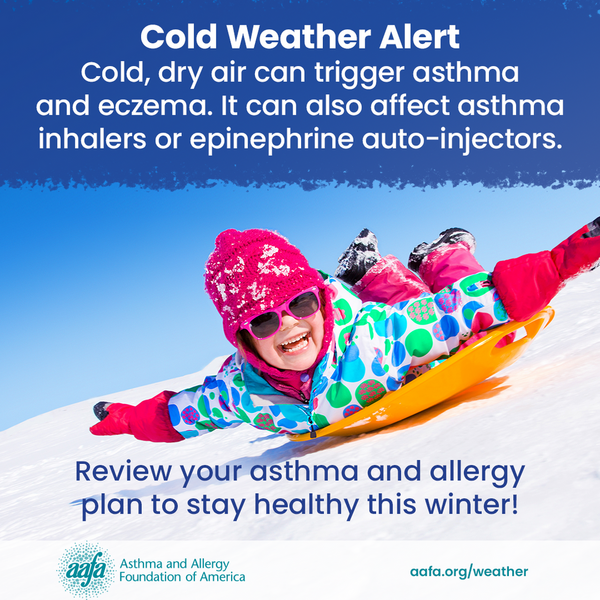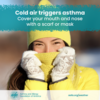As we bundle up during the winter season, people with asthma may notice they have a tougher time breathing during cold weather events. That’s because when you breathe in dry, cold air, your airways start to narrow, making it hard to breathe. Cold air can especially affect your airways when you are doing physical activities that make you breathe through your mouth. When you breathe through your mouth, the cold air can’t be warmed by your nose first before moving to your lungs. This may cause an asthma attack.
There are other reasons why your asthma may flare up in the wintertime, such as:
- Using a wood or gas fireplace to heat your home
- Being indoors more often and for longer periods of the day where indoor air pollution may be at unhealthy levels
- Higher mold counts in wet climates
- Tree pollen allergy if you live in the South where certain pollens like juniper are released in winter months
- Respiratory infections – a very common asthma trigger

There are a few things you can do to reduce your chance of having asthma symptoms or an attack this winter season:
- Wear a scarf or face mask over your mouth and nose when outside in cold temperatures. This will help warm and humidify the air you breathe. The face mask you wear to help prevent the spread of the coronavirus that causes COVID-19 offers this as an added benefit during cold weather.
- Have an Asthma Action Plan. This plan that you create with your doctor helps you know how to use your asthma medicines as prescribed and during an asthma flare-up.
- Know the signs of asthma and the asthma zones (Green, Yellow, Red) on your Asthma Action Plan so you can keep yourself in the healthy Green Zone. Early and prompt treatment when you enter the Yellow Zone can help you get back into the Green Zone.
- Choose indoor activities when the outdoor weather is cold. Yoga, basketball, volleyball, indoor swimming, and martial arts are some good choices to prevent exposure to cold, dry air.
- Carry your asthma inhaler that you use to treat symptoms with you everywhere you go. Keep it accessible before, during, and after exercise.
- Get your flu vaccine. Influenza (flu) can worsen your asthma. Getting a flu vaccine can significantly cut your risk of complications.
- Check your indoor humidity levels. If your home is too humid, it will encourage mold and dust mite growth – both of which can trigger asthma. If your home is too dry, it will dry out your nasal passages and can also impact your breathing. The optimal range for relative humidity is 35 to 50%. If your home’s furnace doesn’t have a built-in option for measuring humidity, you can get a hygrometer (humidity gauge) from hardware stores.
- Improve air flow in your home. Use exhaust fans to vent humid air outside. Inspect your chimney or fireplace if you have one to reduce indoor air pollution from wood burning.
- Consider using a CERTIFIED asthma & allergy friendly® air cleaner to help you improve your indoor air if you will be spending more time indoors during the cold weather. Indoor air quality can often be worse than air quality outside.
- Use AAFA’s Healthier Homes checklist or interactive tool to address other common asthma triggers in your home.

Remember, it is important to keep your inhaler from being fully exposed to extreme cold temperatures. Pack and carry it in an insulated bag or keep it in an inside coat pocket. Don’t store your medicines in your car or somewhere where they may freeze.
We hope these tips are helpful this winter season. Visit aafa.org/weather for need more information on weather-related triggers for asthma.
Medical Review: January 2022 by Neeta Ogden, MD
Get answers to your asthma and allergy questions on our online forums.
Get Support Now


Comments (2)